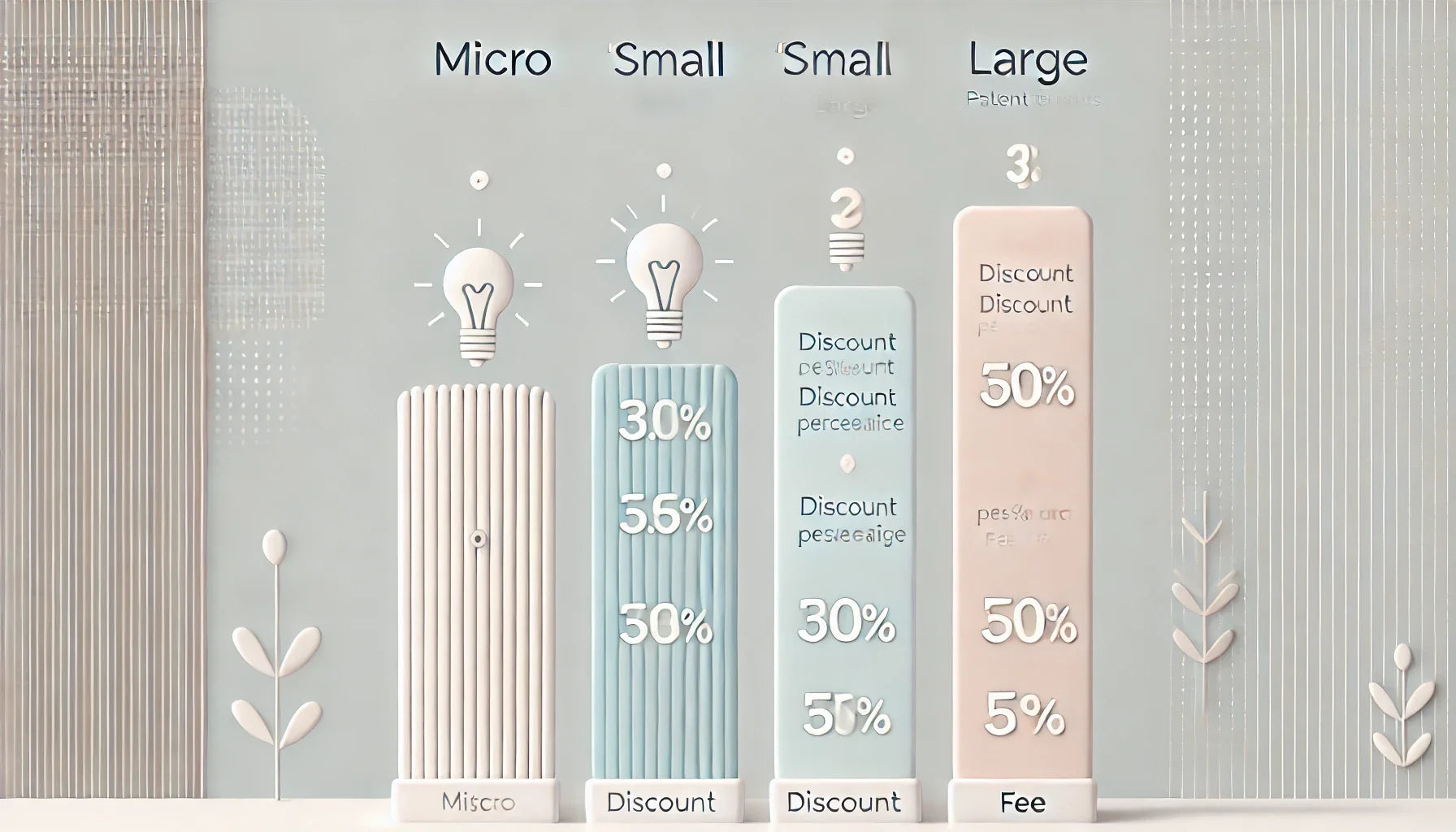📌 Quick Summary
Before you pay your patent filing fees, you need to know your USPTO "entity size"—micro, small, or large. Why? Because it determines how much you’ll pay (or save). This isn’t about your caffeine preference—it’s a legal classification that could cost or save you thousands.
❓ Common Questions & Answers
Q: What is a patent entity size?
A: It’s how the USPTO classifies applicants: micro, small, or large—based on income, organization size, and patent activity. It affects your fee amount.
Q: What qualifies as a micro entity?
A: You must qualify as a small entity, earn less than 3x the median U.S. income, and have filed fewer than four patents. Also, you can't be obligated to assign the rights to a large entity.
Q: How do I claim small or micro entity status?
A: When filing with the USPTO, check the appropriate certification box and ensure you meet all qualifying criteria. False claims = big legal trouble.
Q: What happens if I misrepresent my entity size?
A: You could face fee deficiencies, application rejection, or legal penalties. Honesty isn’t just good—it's required.
Q: Can I change my status later?
A: Yes, if your status changes (e.g., you license to a large entity), you must update the USPTO immediately and pay the appropriate fees moving forward.

📜 Step-by-Step Guide
Step 1: Determine Your Organization Type
Are you an individual, small business, or a mega-corporation? The answer defines your starting point.
Step 2: Review USPTO’s Small Entity Criteria
You qualify if you have fewer than 500 employees and aren’t owned/controlled by a large entity.
Step 3: Check Micro Entity Requirements
You must qualify as a small entity AND meet income and patent-filing limits.
Step 4: Complete the Certification Forms
Submit USPTO Form SB/15A (micro) or indicate small entity status during application filing.
Step 5: Monitor for Status Changes
If your licensing or ownership structure changes, re-certify or reclassify promptly.
📖 Historical Context
Patent entity classifications were introduced by the USPTO to encourage innovation from individuals and small businesses. Before 1982, all applicants paid the same hefty fees—discouraging solo inventors. The Small Business Innovation Development Act helped level the playing field.
In 2011, the America Invents Act (AIA) brought in the micro entity status, offering a 75% discount to truly tiny inventors. This was a game-changer, allowing underdog innovators to access patent protection affordably.
Since then, the USPTO has refined definitions and added strict income and filing thresholds to ensure only qualified applicants benefit. Today, entity status is as essential to filing as the invention itself.

🏢 Business Competition Examples
1. Solo Inventor Startup – EcoSip™
Filed as a micro entity, paid just 25% of standard fees. Used savings to build a prototype and land a pitch on Shark Tank.
2. Mid-Size Tech Firm – ByteNest LLC
Filed as a small entity. With under 500 employees and no large partnerships, they cut 50% of patent fees while scaling their cloud platform.
3. Large Entity – TechTitan Inc.
No discounts. Pays full fees but files over 1,000 patents per year. Their volume strategy offsets the costs.
4. Freelancer Collaboration – CodeSquad Devs
Initially filed as micro entities. But after licensing IP to Google, they were reclassified as large entity status and paid full fees on future filings.

💬 Discussion Section
Let’s be honest—determining your patent entity size feels like navigating a bureaucratic jungle with a blindfold. But it’s crucial. These classifications don’t just exist for fun—they directly impact your finances and IP strategy.
Micro entities are like the "student discount" of the patent world. You get a sweet 75% off, but only if you’re small, solo, and not handing your invention off to a tech giant. Think: garage inventor with ramen budgets and big dreams.
Small entities benefit too—50% savings—but you need to ensure you’re not licensing to or controlled by a larger entity. A partnership with BigTechCo could nudge you into large entity territory.
The danger? Misclassification. It might seem harmless to check a box, but if you’re audited and don’t qualify, your patent could be invalidated, or you could owe back fees (with interest). If that doesn’t scare you, picture your patent being tossed because of a checkbox error.
On the brighter side, filing correctly means you save money, stay compliant, and gain a solid legal foundation. Entity size also signals to investors and partners where you stand—being a scrappy micro entity might even appeal to mission-aligned venture funds.
In short: Size matters. But only the truthful kind.

⚖️ The Debate
FOR Entity Discounts:
-
Encourages solo inventors and small businesses
-
Makes the patent system more inclusive
-
Saves applicants significant funds
-
Reduces barriers to entry for IP protection
AGAINST Entity Discounts:
-
Adds complexity to filing
-
Easier to misclassify accidentally or fraudulently
-
Some argue it slows down USPTO processing
-
Creates gray areas with partnerships and licensing

✅ Key Takeaways
-
Patent entity size determines how much you’ll pay in USPTO fees.
-
Micro entities get 75% off, small entities 50%.
-
Qualification depends on income, company size, and IP ownership.
-
Misrepresentation can cause big legal headaches.
-
Recheck your status regularly—especially when partnerships change.

⚠️ Potential Business Hazards
-
Fee Deficiency Notices for underpayment due to misclassified entity size
-
Loss of Patent Rights if misrepresentation is found
-
Delayed Approvals from incorrect forms or status claims
-
Unexpected Liability when licensing changes entity size without notice
❌ Myths & Misconceptions
-
“Everyone starts as a micro entity.” Nope! Many don’t qualify at all.
-
“You can fudge the numbers—no one checks.” They do. And it’s not worth it.
-
“If you’re a startup, you’re automatically small.” Only if you meet the criteria.
-
“You only check once at filing.” Status must be updated if your situation changes.
-
“It’s cheaper to say you’re smaller.” Only if it’s true. Otherwise, it’s fraud.

📚 Book & Podcast Recommendations
-
Book: Patent It Yourself by David Pressman – https://amzn.to/3TnnVxP
-
Podcast: IP Fridays – https://www.ipfridays.com
-
Podcast: Innovation and IP Matters by WIPO – https://www.wipo.int/pressroom/en/podcasts/
-
Book: The Entrepreneur's Guide to Patents – https://amzn.to/3VfMDeB
⚖️ Legal Cases
-
Zoltek Corp. v. United States – https://casetext.com/case/zoltek-corp-v-united-states
Issue: Entity size misclassification led to government IP disputes. -
Hyatt v. USPTO – https://casetext.com/case/hyatt-v-uspto
Issue: Prolonged USPTO delays and fee structure debates. -
Kingsdown Med. Consultants, Ltd. v. Hollister Inc. – https://casetext.com/case/kingsdown-med-consultants-v-hollister
Issue: Good faith vs. intent in patent applications. -
Therasense, Inc. v. Becton, Dickinson and Co. – https://casetext.com/case/therasense-inc-v-becton-dickinson-and-co
Issue: Material misrepresentation and inequitable conduct.

📣 Expert Invitation
Have thoughts on entity classification or been through a wild patent fee ride? Share your story or insights at http://inventiveunicorn.com – your experience might help the next micro-sized innovator go mega!
🔚 Wrap-Up Conclusion
Whether you’re flying solo or filing patents as a booming business, getting your entity size right isn’t optional—it’s essential. Because this isn’t Starbucks. It’s the USPTO. And the only thing worse than overpaying is misfiling.












